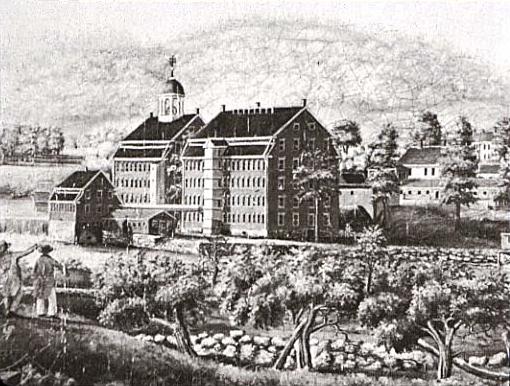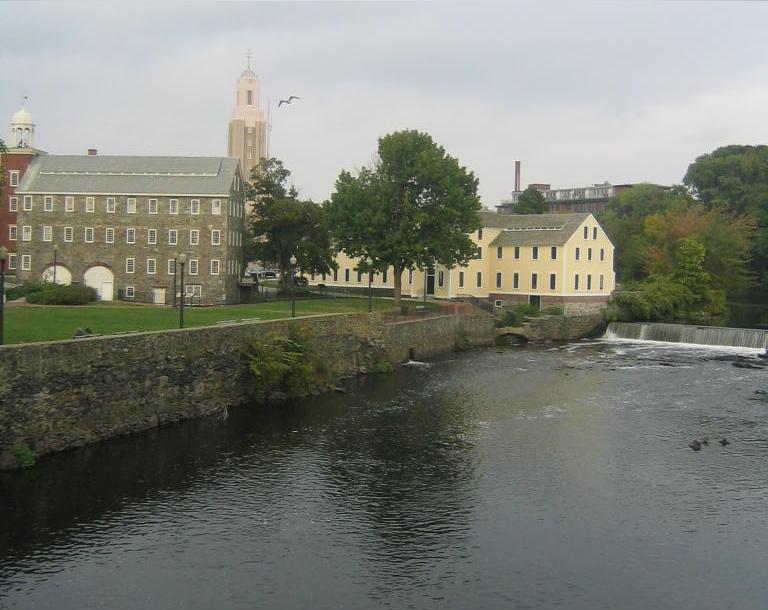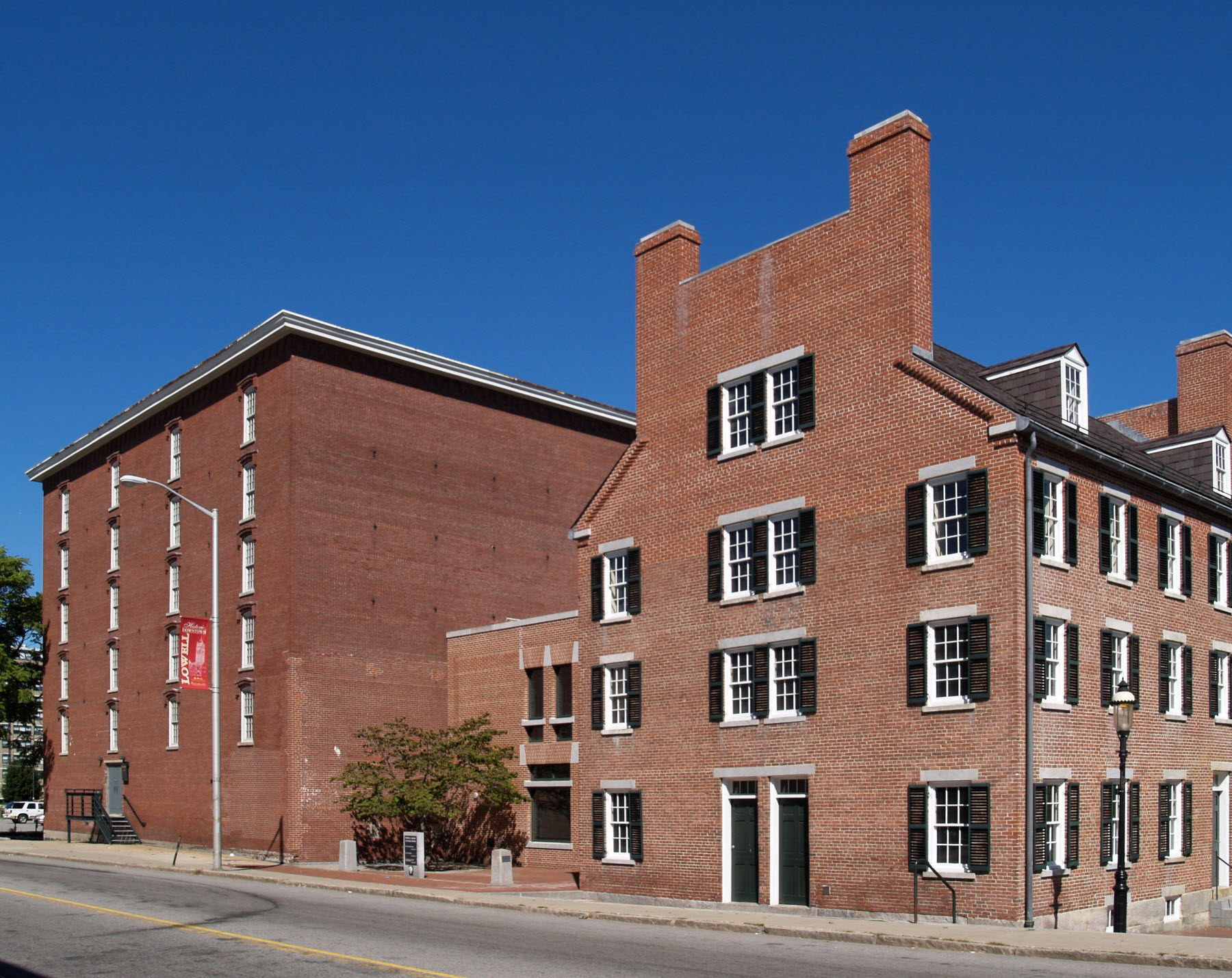Waltham-Lowell system on:
[Wikipedia]
[Google]
[Amazon]
 The Waltham-Lowell system was a labor and production model employed during the rise of the
The Waltham-Lowell system was a labor and production model employed during the rise of the
 The precursor to the Waltham-Lowell system was seen in
The precursor to the Waltham-Lowell system was seen in
 While the
While the
 Eventually, cheaper and less organized foreign labor replaced the mill girls. Even by the time of the founding of Lawrence in 1845, there were questions being raised about its viability.http://www.historycooperative.org/journals/mhr/2/ford.html Peter A. Ford - "Father of the whole enterprise"
Charles S. Storrow and the Making of Lawrence, Massachusetts, 1845–1860 One of the leading causes of this transition to foreign labor and the demise of the system was the coming of the Civil War. Girls went to be nurses, back to their farms, or into positions that men had left when they went to the army.MacDonald 1937, p. 61 These girls were out of the mills for the duration of the war and when the mills reopened after the war, the girls were gone because they no longer needed the mills. They had rooted into their new occupations or moved on in life to the point where the mill was no longer suitable for them. The lack of mill girls created a movement towards Irish immigrants.
The Irish community that was building in Lowell, Massachusetts was not exclusively female unlike the grouping of mill girls in the dormitories.Dublin 1975, p. 34 The proportion of male employment at the mill increased which rapidly changed the demographics of the people that work there. The Lowell plant became heavily dependent on the foreign lower-class, especially the Irish immigrants that flocked to Massachusetts. This reliance on foreign workers forced the mills to become what they had been trying to avoid with the mill girls. Poverty snuck up on them and they were forced to deal with slums and a poor lower-class. These immigrants tended to have families and they did not live in the dormitory-style of the mill girls. While in many cases the boardinghouses outlived the system, families of immigrant workers typically lived in tenement neighborhoods, and off company property.
Eventually, cheaper and less organized foreign labor replaced the mill girls. Even by the time of the founding of Lawrence in 1845, there were questions being raised about its viability.http://www.historycooperative.org/journals/mhr/2/ford.html Peter A. Ford - "Father of the whole enterprise"
Charles S. Storrow and the Making of Lawrence, Massachusetts, 1845–1860 One of the leading causes of this transition to foreign labor and the demise of the system was the coming of the Civil War. Girls went to be nurses, back to their farms, or into positions that men had left when they went to the army.MacDonald 1937, p. 61 These girls were out of the mills for the duration of the war and when the mills reopened after the war, the girls were gone because they no longer needed the mills. They had rooted into their new occupations or moved on in life to the point where the mill was no longer suitable for them. The lack of mill girls created a movement towards Irish immigrants.
The Irish community that was building in Lowell, Massachusetts was not exclusively female unlike the grouping of mill girls in the dormitories.Dublin 1975, p. 34 The proportion of male employment at the mill increased which rapidly changed the demographics of the people that work there. The Lowell plant became heavily dependent on the foreign lower-class, especially the Irish immigrants that flocked to Massachusetts. This reliance on foreign workers forced the mills to become what they had been trying to avoid with the mill girls. Poverty snuck up on them and they were forced to deal with slums and a poor lower-class. These immigrants tended to have families and they did not live in the dormitory-style of the mill girls. While in many cases the boardinghouses outlived the system, families of immigrant workers typically lived in tenement neighborhoods, and off company property.
Fire map of the Merrimack Manufacturing Company and Dutton and Worthen Street boardinghouses, 1924
Boardinghouses and their demolition, the 1960s
More boardinghouses, the 1960s
Economic history of Massachusetts History of Lowell, Massachusetts History of the textile industry in the United States
 The Waltham-Lowell system was a labor and production model employed during the rise of the
The Waltham-Lowell system was a labor and production model employed during the rise of the textile industry
The textile industry is primarily concerned with the design, production and distribution of yarn, textile, cloth and clothing. The raw material may be Natural material, natural, or synthetic using products of the chemical industry.
Industry p ...
in the United States, particularly in New England
New England is a region comprising six states in the Northeastern United States: Connecticut, Maine, Massachusetts, New Hampshire, Rhode Island, and Vermont. It is bordered by the state of New York to the west and by the Canadian provinces ...
, amid the larger backdrop of rapid expansion of the Industrial Revolution
The Industrial Revolution was the transition to new manufacturing processes in Great Britain, continental Europe, and the United States, that occurred during the period from around 1760 to about 1820–1840. This transition included going f ...
in the early 19th century.
Made possible by inventions such as the spinning jenny, spinning mule, and water frame around the time of the American Revolution
The American Revolution was an ideological and political revolution that occurred in British America between 1765 and 1791. The Americans in the Thirteen Colonies formed independent states that defeated the British in the American Revoluti ...
, the textile industry was among the earliest mechanized industries, and models of production and labor sources were first explored here.
The system used domestic labor, often referred to as mill girls, who came to the new textile centers from rural towns to earn more money than they could at home, and to live a cultured life in "the city." Their life was very regimented—they lived in the company boardinghouses and were held to strict hours and a moral code.
As competition grew in the domestic textile industry and wages declined, strikes began to occur, and with the introduction of cheaper imported foreign workers by mid-century, the system proved unprofitable and collapsed.
Precursor
Rhode Island
Rhode Island (, like ''road'') is a U.S. state, state in the New England region of the Northeastern United States. It is the List of U.S. states by area, smallest U.S. state by area and the List of states and territories of the United States ...
, where British immigrant Samuel Slater set up his first spinning mills in the 1790s.
Slater drew on his British village experience to create a factory system called the "Rhode Island System," based on the customary patterns of family life in New England villages. Children aged 7 to 12 were the first employees of the mill; Slater personally supervised them closely. The first child workers were hired in 1790. It is highly unlikely that Slater resorted to physical punishment, relying on a system of fines. Slater first tried to staff his mill with women and children from afar, but that fell through due to the close-knit framework of the New England family. He then brought in whole families, creating entire towns. He provided company-owned housing nearby, along with company stores; he sponsored a Sunday School where college students taught the children reading and writing.
Characteristics
The Waltham-Lowell system pioneered the use of a vertically integrated system.Dublin 1989, p. 160 Here there was complete control over all aspects of production. Spinning, weaving, dyeing, and cutting were now completed in a single plant. This large amount of control made it so that no other company could interfere with production. The Waltham mill also pioneered the process ofmass production
Mass production, also known as flow production or continuous production, is the production of substantial amounts of standardized products in a constant flow, including and especially on assembly lines. Together with job production and ba ...
. This greatly increased the scale of manufacturing. Water-powered line shafts and belts now connected hundreds of power lines. The increase in manufacturing occurred so rapidly that there was no localized labor supply in the early 19th century that could have sufficed. Lowell solved this problem by hiring young women.
Waltham
After the successes of Samuel Slater, a group of investors now calledThe Boston Associates
The Boston Associates were a loosely linked group of investors in 19th-century New England. They included Nathan Appleton, Patrick Tracy Jackson, Abbott Lawrence, and Amos Lawrence. Often related directly or through marriage, they were based in ...
and led by Newburyport, Massachusetts
Newburyport is a coastal city in Essex County, Massachusetts, United States, northeast of Boston. The population was 18,289 at the 2020 census. A historic seaport with vibrant tourism industry, Newburyport includes part of Plum Island. The mo ...
merchant Francis Cabot Lowell devised a new textile operation on the Charles River
The Charles River ( Massachusett: ''Quinobequin)'' (sometimes called the River Charles or simply the Charles) is an river in eastern Massachusetts. It flows northeast from Hopkinton to Boston along a highly meandering route, that doubles bac ...
in Waltham, Massachusetts
Waltham ( ) is a city in Middlesex County, Massachusetts, United States, and was an early center for the labor movement as well as a major contributor to the American Industrial Revolution. The original home of the Boston Manufacturing Company, ...
, west of Boston
Boston (), officially the City of Boston, is the state capital and most populous city of the Commonwealth of Massachusetts, as well as the cultural and financial center of the New England region of the United States. It is the 24th- mo ...
. This new firm, the first in the nation to place cotton-to-cloth production under one roof, was incorporated as the Boston Manufacturing Company
The Boston Manufacturing Company was a business that operated one of the first factories in America. It was organized in 1813 by Francis Cabot Lowell, a wealthy Boston merchant, in partnership with a group of investors later known as The Boston ...
in 1814.
The Boston Associates tried to create a controlled system of labor, unlike the harsh conditions they observed while in Lancashire
Lancashire ( , ; abbreviated Lancs) is the name of a historic county, ceremonial county, and non-metropolitan county in North West England. The boundaries of these three areas differ significantly.
The non-metropolitan county of Lancas ...
, England. The owners recruited young New England farm girls from the surrounding area to work the machines at Waltham. The mill girls lived in company boarding houses and were subject to strict codes of conduct and supervised by older women. They worked about 80 hours per week. Six days per week, they woke to the factory bell at 4:40 am and reported to work at 5 am before a half-hour breakfast break at 7 am. They worked until a lunch break of 30 to 45 minutes around noon. The workers then returned to their company houses at 7 pm when the factory closed. This system became known as the Waltham System.
Lowell
 While the
While the Boston Manufacturing Company
The Boston Manufacturing Company was a business that operated one of the first factories in America. It was organized in 1813 by Francis Cabot Lowell, a wealthy Boston merchant, in partnership with a group of investors later known as The Boston ...
proved immensely profitable, the Charles River
The Charles River ( Massachusett: ''Quinobequin)'' (sometimes called the River Charles or simply the Charles) is an river in eastern Massachusetts. It flows northeast from Hopkinton to Boston along a highly meandering route, that doubles bac ...
had very little potential as a power source. Francis Cabot Lowell died prematurely in 1817, and soon his partners traveled north of Boston to East Chelmsford, Massachusetts, where the large Merrimack River
The Merrimack River (or Merrimac River, an occasional earlier spelling) is a river in the northeastern United States. It rises at the confluence of the Pemigewasset and Winnipesaukee rivers in Franklin, New Hampshire, flows southward into Mas ...
could provide far more power. The first mills, the Merrimack Manufacturing Company, were running by 1823. The settlement was incorporated as the town of Lowell in 1826, and became the city of Lowell ten years later. Boasting ten textile corporations, all running on the Waltham System and each considerably larger than the Boston Manufacturing Company, Lowell became one of the largest cities in New England and the model, now known as the Lowell System, was copied elsewhere in New England, often in other mill towns
A mill town, also known as factory town or mill village, is typically a settlement that developed around one or more mills or factories, usually cotton mills or factories producing textiles. Europe
Italy
* ''Crespi d'Adda'', UNESCO World He ...
developed by the Boston Associates. Examples include Manchester, New Hampshire; Lewiston, Maine
Lewiston (; ; officially the City of Lewiston, Maine) is List of cities in Maine, the second largest city in Maine and the most central city in Androscoggin County, Maine, Androscoggin County. The city lies halfway between Augusta, Maine, August ...
; Lawrence, Massachusetts
Lawrence is a city located in Essex County, Massachusetts, United States, on the Merrimack River. At the 2020 census, the city had a population of 89,143. Surrounding communities include Methuen to the north, Andover to the southwest, and Nort ...
; and Holyoke, Massachusetts
Holyoke is a city in Hampden County, Massachusetts, United States, that lies between the western bank of the Connecticut River and the Mount Tom Range. As of the 2020 census, the city had a population of 38,238. Located north of Springfiel ...
.
Decline
 Eventually, cheaper and less organized foreign labor replaced the mill girls. Even by the time of the founding of Lawrence in 1845, there were questions being raised about its viability.http://www.historycooperative.org/journals/mhr/2/ford.html Peter A. Ford - "Father of the whole enterprise"
Charles S. Storrow and the Making of Lawrence, Massachusetts, 1845–1860 One of the leading causes of this transition to foreign labor and the demise of the system was the coming of the Civil War. Girls went to be nurses, back to their farms, or into positions that men had left when they went to the army.MacDonald 1937, p. 61 These girls were out of the mills for the duration of the war and when the mills reopened after the war, the girls were gone because they no longer needed the mills. They had rooted into their new occupations or moved on in life to the point where the mill was no longer suitable for them. The lack of mill girls created a movement towards Irish immigrants.
The Irish community that was building in Lowell, Massachusetts was not exclusively female unlike the grouping of mill girls in the dormitories.Dublin 1975, p. 34 The proportion of male employment at the mill increased which rapidly changed the demographics of the people that work there. The Lowell plant became heavily dependent on the foreign lower-class, especially the Irish immigrants that flocked to Massachusetts. This reliance on foreign workers forced the mills to become what they had been trying to avoid with the mill girls. Poverty snuck up on them and they were forced to deal with slums and a poor lower-class. These immigrants tended to have families and they did not live in the dormitory-style of the mill girls. While in many cases the boardinghouses outlived the system, families of immigrant workers typically lived in tenement neighborhoods, and off company property.
Eventually, cheaper and less organized foreign labor replaced the mill girls. Even by the time of the founding of Lawrence in 1845, there were questions being raised about its viability.http://www.historycooperative.org/journals/mhr/2/ford.html Peter A. Ford - "Father of the whole enterprise"
Charles S. Storrow and the Making of Lawrence, Massachusetts, 1845–1860 One of the leading causes of this transition to foreign labor and the demise of the system was the coming of the Civil War. Girls went to be nurses, back to their farms, or into positions that men had left when they went to the army.MacDonald 1937, p. 61 These girls were out of the mills for the duration of the war and when the mills reopened after the war, the girls were gone because they no longer needed the mills. They had rooted into their new occupations or moved on in life to the point where the mill was no longer suitable for them. The lack of mill girls created a movement towards Irish immigrants.
The Irish community that was building in Lowell, Massachusetts was not exclusively female unlike the grouping of mill girls in the dormitories.Dublin 1975, p. 34 The proportion of male employment at the mill increased which rapidly changed the demographics of the people that work there. The Lowell plant became heavily dependent on the foreign lower-class, especially the Irish immigrants that flocked to Massachusetts. This reliance on foreign workers forced the mills to become what they had been trying to avoid with the mill girls. Poverty snuck up on them and they were forced to deal with slums and a poor lower-class. These immigrants tended to have families and they did not live in the dormitory-style of the mill girls. While in many cases the boardinghouses outlived the system, families of immigrant workers typically lived in tenement neighborhoods, and off company property.
See also
* Mills and Factories in the Industrial United States * Lowell mill girlsReferences
* *Notes
{{reflistExternal links
Fire map of the Merrimack Manufacturing Company and Dutton and Worthen Street boardinghouses, 1924
Boardinghouses and their demolition, the 1960s
More boardinghouses, the 1960s
Economic history of Massachusetts History of Lowell, Massachusetts History of the textile industry in the United States